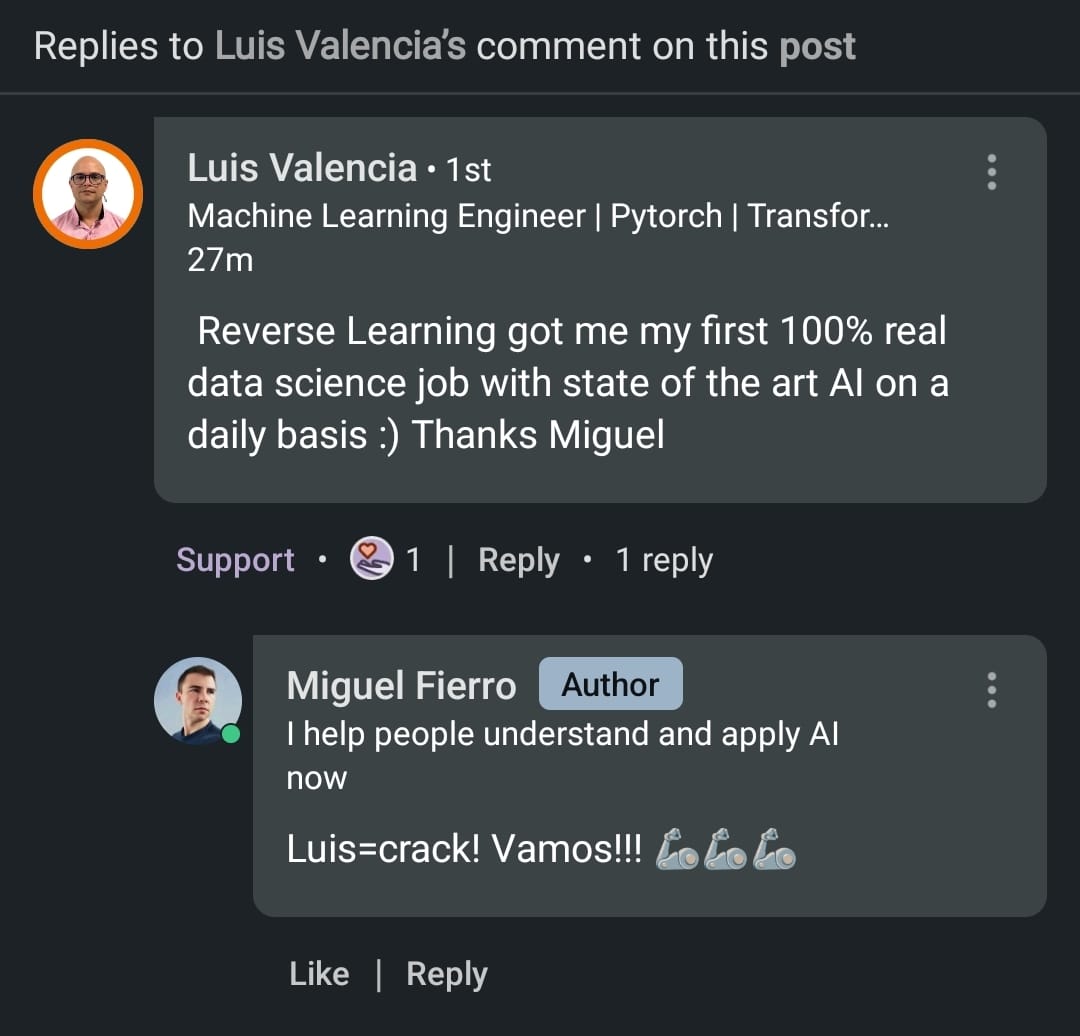Luis Valencia wanted to switch his career to work in AI, and he did it. He went from Cloud Solution Architect to Data Scientist, 4 months after we started working together.
During our coaching sessions, we worked on different ways to improve his resume, LinkedIn profile, and AI skills. Still, the two strategies that were more impactful were Reverse Learning and T-shaped professional.

Let me go first through one of the concepts, Reverse Learning. The idea is simple, instead of starting from the basic AI algorithms and going to what is used today, reverse the path, start from the techniques used today in the industry, and go back to the basics.
Data Science is one of the newest and coolest jobs. It's the hottest job of the XXI century, it has one of the highest salaries and we are changing the world. Many people want to switch their careers to work in AI. Some people think it is impossible for them, some think they require a PhD or an expensive Master's degree, and some believe you need to be a mathematical genius.
They are wrong, and Luis is a good example of it. Anyone can learn AI, and anyone can switch their career and work in that field.
The question is, how?
Reverse Learning
Reverse Learning is a learning methodology that maximizes usefulness. You prioritize the skills that companies are requesting to increase the chances to switch your career and find a job in the field.
Let's do a thought experiment. It could be argued that the oldest job in human history is fighting. We have been fighting for thousands of years.
Now, imagine that I am called to become a soldier, so I have to switch my career from Data Scientist to soldier, and I have to do it as fast as possible. What would I do?
Would I start studying the techniques and strategies of the best generals of history like Alexander the Great or Julius Ceasar? No.
Would I spend hours and hours reading books and novels about war? No.
Would I study the history of war, from the Roman Empire to the Middle Ages, to the Napoleonic Wars? No.
Probably, I would learn how to operate a $100k drone that can destroy a $50M tank.
Learning how to conquer Asia with Elephants like Alexander the Great did is not useful. Learning to operate a drone is.
Going back to today, here is the reason why a lot of people can't switch their careers to AI and fail the interviews: they learn the history of AI, instead of learning the AI that is used in companies today.
People know everything about linear regression, but nothing about Gradient Boosting Decision Trees (GBDT). They know LSTMs, but not Transformers.
Companies with tabular data need people who understand GBDT, companies with text data need people who understand Transformers.
Reverse learning is all about prioritizing what is useful and then reversing to other areas.
Are you still not convinced? Do you think it is impossible to learn Transformers without learning first SVM, LSTMs, etc? Do you think that others can do it, but not you? Next is the journey of Luis.
Luis' Journey to Data Scientist
1. Tell me a little bit about yourself
I have 20 years of experience in total, as Software Developer, Cloud Solutions Architect, and a few years ago I wanted to move to something more challenging and rewarding.
As Architect I felt that I wasn't doing enough to have my brain upskilled.
2. Where were you working before, we met and why did you want to change?
In one of the Big 4 in Belgium, I wanted to move because there is no AI team there, they don't invest in AI or Data Science, and the manager was not great at managing technically skilled people. So, I decided to start looking for something more fun, more rewarding, and with a better manager of course. I was in a team of 1, doing everything with no teamwork at all, it was very frustrating.
3. How long did it take from when we started working together to when you got your new position?
Less than 4 months
4. Of everything we discussed and the material I shared with you, what did you use to prepare for the interview?
I worked a lot with my GitHub portfolio, more than 10 projects are already uploaded, and I worked a lot on an improved Data Science version of my CV, this was indeed the most important aspect, it got me many interviews.
5. How do you feel right now?
I am very happy, the company I work for cares a lot about people's technical skills. There is time allocated for everyone to upskill. And I am working on the State of The Art! LLMs, OpenAI, LangChain, HuggingFace, etc. It's like a dream come true. Now I have time to learn what I want which was in line with the vision of my employer and I do this by actually practicing and building products for clients.
6. What advice would you give to people applying for a Data Science position?
Become a T-shaped professional as advised by Miguel, and Reverse Learning, these 2 things changed the way I was approaching learning.
